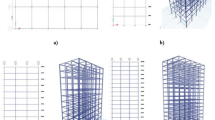Abstract
Two different approaches are considered by seismic codes for estimating the seismic drifts of moment resisting steel frames (MRSFs). The first approach which is adopted by the European and the Canadian codes is driven by the equal displacement rule and defines the deflection amplification factor (DAF) to be equal to the response modification factor R. The second approach which is motivated by the opinion of professionals who believe that the equal displacement rule often over-estimates displacements is employed by the ASCE 7-10 and the Egyptian seismic code, where the DAF is considered equal to a fraction of R. This study evaluates the two approaches considered for estimating the seismic drifts of MRSFs. Four MRSF buildings having 2-, 4-, 8- and 12-stories have been designed under variable levels of seismic intensity. Five lateral-stiffness scenarios are considered for each building to account for the stiffness increase due to the nonstructural components as well as the modeling approximations. The seismic drifts of the MRSFs are calculated under the effect of twenty-two pairs of far-field ground motion records by time history analysis and with using the code simplified approaches. The results obtained indicate that the current code approaches of amplifying the elastic drifts significantly overestimate the seismic drifts of buildings designed under low level of seismicity. In contrast, the ASCE 7-10 and the Egyptian code approaches of estimating the seismic drifts underestimate the maximum story drift ratios under earthquake loading for long period buildings designed under high level of seismicity.















Similar content being viewed by others
References
Abou-Elfath H (2019) Evaluating the inelastic displacement ratios of moment-resisting steel frames designed according to the Egyptian code. Earthq Eng Eng Vib 18(1):159–170
ASCE 7 (2010) Minimum design loads for buildings and other structures. American Society of Civil Engineers/Structural Engineering Institute, Reston, VA
ECP-201 (2012) Egyptian code for calculating loads and forces in structural work and masonry. Housing and Building National Research Center, Ministry of Housing, Utilities and Urban Planning, Cairo, Egypt
Euro code 8 (2004) Design of structures for earthquake resistance, part 1: General rules, seismic actions, and rules for buildings. EN 1998-1, European Committee for Standardization, Brussels, Belgium
FEMA (2009), Quantification of building seismic performance factors, FEMA P695, Prepared by the Applied Technology Council for the Federal Emergency Management Agency, Washington, D.C
Krawinkler H (1996) Pushover analysis: why, how, when, and when not to use it. In: The 65 annual convention of the structural engineers association of California, Maui, Hawaii, pp 17–36
Miranda E (2001) Estimation of inelastic deformation demands of SDOF systems. J Struct Eng 127:1005–1012
Miranda E, Bertero VV (1994) Evaluation of strength reduction factors for earthquake resistant design. Earthq Spectra 10(2):357–379
Mollaioli F, Mura A, Decanini LD (2007) Assessment of the deformation demand in multi-storey frames. J Seismol Earthq Eng 8(4):203–219
NBCC (2010) National building code of Canada. National Research Council of Canada, Ottawa, Ontario
Prakash V, Powell GH. (1993) DRAIN-2DX- Version 1.02: User Guide. Report No. UCB/SEMM-93/17, Civil Engineering Department, University of California at Berkeley
Uang CM, Maarouf A (1994) Deflection amplification factor for seismic design provisions. J Struct Eng 120(8):2423–2436
UBC (1997) Uniform Building Code. International Conference of Building Officials (ICBO), Whittier, California, USA
Veletsos AS, Newmark NM (1960) Effect of inelastic behavior on the response of simple systems to earthquake motions. In: The 2nd world conference on earthquake engineering, Tokyo, Japan, vol 2, pp 895–912
Woessner J, Laurentiu D, Giardini D et al (2013) The 2013 European Seismic Hazard Model: key components and results. Bull Earthq Eng 13:3553–3596
Author information
Authors and Affiliations
Corresponding author
Additional information
Publisher's Note
Springer Nature remains neutral with regard to jurisdictional claims in published maps and institutional affiliations.
Rights and permissions
About this article
Cite this article
Abou-Elfath, H., Elhout, E. Evaluating the code approaches for estimating the seismic drifts of steel frame buildings designed under variable levels of seismicity. Bull Earthquake Eng 17, 4169–4191 (2019). https://doi.org/10.1007/s10518-019-00634-z
Received:
Accepted:
Published:
Issue Date:
DOI: https://doi.org/10.1007/s10518-019-00634-z




